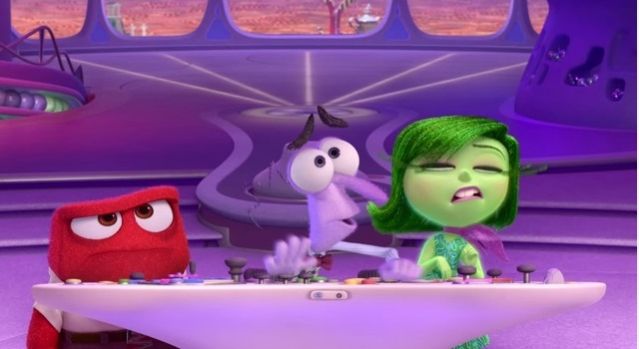Memory
Inside Out: Emotional Truths by Way of Pixar
"Inside Out" proves true to cognitive, developmental, and clinical psychology.
Posted June 24, 2015 Reviewed by Kaja Perina

Dr. Janina Scarlet reviewed the film Inside Out and wanted to share her thoughts with Psychology Today readers.
by Janina Scarlet
Inside Out is a movie I’d been waiting for a year to see and, once again, Pixar did not disappoint. This is a movie I’m going to be assigning to many of my patients and doctoral students as a way to demonstrate important psychological principles.
Warning: some spoilers of the movie ahead.
The movie is about an 11-year-old girl, Riley, originally from Minnesota, who moves to San Francisco with her parents. The leading characters of the movie, however, aren’t Riley and her family, but Riley’s primary emotions: Happiness (Joy), Sadness, Fear, Anger, and Disgust. These emotions demonstrate what it might be like in the mind of an 11-year-old girl who struggles with having to move to a different city, away from her friends, away from her hockey league, and has a hard time pretending to be happy for her parents.
What’s really powerful about this film is how accurate it is to cognitive, developmental, and clinical psychology. The 5 emotions used in this film are in fact 5 of the 6 scientifically validated universal emotions (the 6th one being surprise). Psychologist and scientist, Paul Ekman, is most known for his work with universal emotions as he traveled around the world and found that these were present in every culture and presented in the same way through the same facial expressions around the world. Ekman’s work has been used for psychology research, as well as for the US government, and even inspired the popular television series, ‘Lie to Me’.
Other concepts displayed in this movie included the conversion of short to long-term memory. When a memory is seen as salient or relevant enough to us, or when it has been repeated enough times, the brain messengers, dopamine and glutamate, ensure the long-term encoding of that memory. Think of these messengers as computer coders or awesome IT support team – they write the code to ensure that our brain computer is up to date with the new information. Other concepts briefly covered in the movie include psychological changes of reaching/approaching puberty, psychological stressors, family psychology, inductive and deductive reasoning (thinking like Sherlock Holmes by using logic, reasoning, and observation to reach a conclusion), and many others.
Of all 5 of Riley’s emotions, Joy seems to be the leader, she keeps the others in check but reminds the viewers that all of them have an important function. She states that Disgust keeps Riley safe from being poisoned, Fear keeps her safe from a catastrophe by imagining worst case scenarios, Anger protects her from others and also allows her to be a better hockey player, while Joy ensures that Riley is happy. However, Joy fails to see the importance of Sadness and tries to shoo Sadness away from anything Riley-related, forbidding this emotion in every way possible. She even draws a circle on the floor and makes Sadness stay inside it, forbidding her to leave or to touch any of Riley’s memories, so as not to taint them with sad memories.
As if Riley’s mind trying to keep Sadness at bay wasn’t enough, Riley’s parents put an additional pressure on her, especially when her mother asks her to “keep smiling” for her dad. Essentially, Riley’s mom, without meaning to do so, communicates to Riley that being sad about the move was not ok and that she needs to pretend to be happy to support her father through this.
Unfortunately, Joy’s good intentions backfire when Riley is unable to receive the support she so desperately needs to help her with adjusting to her new environment. In fact, Riley initially seems to be having symptoms of an Adjustment Disorder with Depressed Mood, where she has a hard time coping with her move, she withdraws from her parents and old friends, she misses school, and even tries to run away. By being unable to experience her sadness about all these changes and pretending that she was ok, Riley ends up being angry, anxious, and irritable, getting into a fight with her parents and her best friend, before shutting down altogether. In fact, it looks like Riley’s potential Adjustment Disorder might have turned into a full-blown Major Depressive Episode. (I’m saying, “might have” because in order to be diagnosed, the symptoms need to have lasted for 2 weeks or more, and we don’t know how long Riley’s symptoms actually lasted).
What messages does this movie send to its viewers?
Many, actually, but perhaps the most important one is this – our emotions are all important, every single one of them. They all serve an important function and we cannot selectively feel some but not others. It’s an “all-or-none” deal. If we numb sadness, we also numb joy. We need to openly experience all our emotions, and that includes sadness, as painful as it may be sometimes. Sadness allows for connection, when we see someone else feeling sad, we might feel sad too (this emotion is called empathy) and might want to alleviate their sadness (this is compassion). When we stay with this individual and share our emotions together, the resonating effect can produce a healing experience. That is exactly what we see when Sadness comforts Riley’s imaginary friend, Bing Bong, and also when Riley is able to share her sadness with her parents.
In fact, when we are sad, our body and facial expression cue the people around us that we need help – the tears running down our face, the pupil dilation, the non-threatening posture, all of this signals others that we could use some support. And at the same time, the people around us might then experience a bitter-sweet sensation of compassion, caused by an activation of the compassion centers of our brain (the insula and the anterior cingulate cortex, among other structures), and the warmth of the heart caused by a release of a special “cuddle” hormone, oxytocin (so called because it is released when we want to or are in the process of hugging someone, or similar actions).
The movie doesn’t stop there; it ends with a bang by reminding us that we can experience multiple (and even contradictory) emotions at the same time, such as happiness and sadness. The movie also shows that everyone experiences these emotions, as they are, in fact, universal. This demonstrates a psychological concept of common humanity, or the idea that other people are just like us, they might struggle with the same emotions, insecurities, heartbreaks, and neuroses as we do, further validating our internal experiences.
Overall, ‘Inside Out’ was amazing. I highly recommend it and would love to hear your opinions on it.
Dr. Janina Scarlet is a Licensed Clinical Psychologist, a scientist, and a full time geek. She uses Superhero Therapy to help patients with anxiety, depression, chronic pain, and PTSD at the Center for Stress and Anxiety Management and Sharp Memorial Hospital. Dr. Scarlet also teaches at Alliant International University, San Diego. Her book, Superhero Therapy, is expected to be released in July 2016 with Little, Brown Book Group.
Original post at Superhero Therapy: Psychology of "Inside Out."
Shared at the author's request, with permission.




